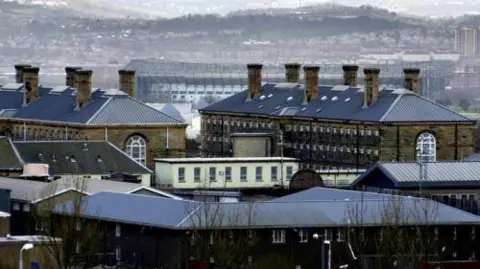Proposal for Barlinnie to become A-listed building
 PA Media
PA MediaA public consultation has been launched on proposals to designate Scotland's largest prison as a category A listed building.
HMP Barlinnie, in the northeast of Glasgow, is the most complete surviving example of a 19th century prison in Scotland and considered important in the history of Scottish prison design and criminal justice.
The proposed listing by Historic Environment Scotland (HES) would cover the Victorian parts of the prison site developed between 1880 and 1908.
The consultation will run until 22 January, with HES seeking opinions from the public on the proposal.
Construction of Barlinnie started in 1880 and the site opened two years later.
It was the first prison to be built in Scotland following the nationalisation of the prison system a few years earlier.
The building work continued through the late 19th century, and the jail continued to expand and be modernised in the 20th and 21st centuries.
HES said the majority of the early prison buildings, including the halls, chapel, hospital, workshops, gate house and sections of the boundary wall, are still standing today.
But life in the Glasgow was prison was said to be tough, with prisoners nicknaming it "Bar-hell" as its five blocks were overcrowded and violence-ridden.
Misbehaviour would often result in inmates being handcuffed and left in a canvas jacket through the night.
In the mid-20th century, it was a place of capital punishment with 10 men hanged at the site in the period between 1946 and 1960 - before it was abolished in 1965.
 Newsquest
NewsquestIn contrast, an experimental Special Unit, which opened in 1974 took a new approach to reforming some of Barlinnie's most violent inmates, allowing them greater freedoms.
Prisoners could wear their own clothes and had increased access to their families.
They were also encouraged to explore creative activities and the unit achieved high-profile success stories before it closed in 1994, such as Jimmy Boyle who became a sculptor and writer.
However, it was not until 2004 that every cell had its own toilet. Today it remains cramped and outdated.
A replacement for the 142-year-old jail was due to open in 2025 - but that has been pushed back to 2027.

Listing is the process that identifies, designates and provides statutory protection for buildings of special architecture or historic interest.
It ensures that what is special about a structure is taken into account in decisions about its future.
Category A offers the highest level of protection for a building in Scotland.
Dara Parsons, Head of Designations at HES, said: "Barlinnie certainly holds a place in the national consciousness and is a rare and outstanding example of a purpose-built prison complex in Scotland, significant as the largest and most complete surviving example of its building type.
"We have not yet decided whether to list Barlinnie and we would encourage anyone with views on the building's significance or any information that may help inform our final decision to review our report and take part in our consultation."
